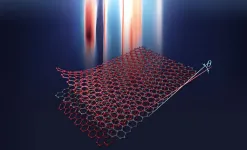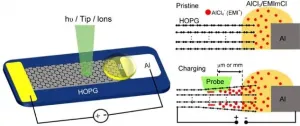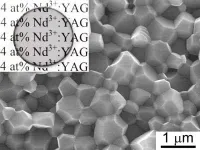(Press-News.org) Treatment for HIV has improved tremendously over the past 30 years; once a death sentence, the disease is now a manageable lifelong condition in many parts of the world. Life expectancy is about the same as that of individuals without HIV, though patients must adhere to a strict regimen of daily antiretroviral therapy, or the virus will come out of hiding and reactivate. Antiretroviral therapy prevents existing virus from replicating, but it can't eliminate the infection. Many ongoing clinical trials are investigating possible ways to clear HIV infection.
In a study published Feb. 4 in the journal Science, researchers at Washington University School of Medicine in St. Louis have identified a potential way to eradicate the latent HIV infection that lies dormant inside infected immune cells. Studying human immune cells, the researchers showed that such cells have a natural alarm system that detects the activity of a specific HIV protein. Rather than attack the virus based on its appearance, which is the basis of most immunotherapies, this strategy is to attack the virus based on what it is doing -- vital activities that are required for the virus to exist.
HIV is nearly impossible to eradicate because the immune system can't keep up with its unusually rapid mutation rate, constantly changing the way it looks to evade immune attack -- akin to a spy quickly changing appearance to evade authorities. Just as the body's immune cells learn to recognize one manifestation of the virus, it already has changed into multiple new disguises.
"When we identified a part of the immune system that could recognize and attack a core function of the HIV virus -- rather than what it looks like -- it was really exciting," said senior author Liang Shan, PhD, an assistant professor of medicine. "An analogy might be that it's relatively easy to change clothes or hairstyle to go undetected, but it's impossible to conceal running. This is exciting because it raises the possibility of clearing all the dormant virus in a single patient -- no matter how widely mutated -- based on something all the viral variants have in common. For patients, even if they are consistent with therapy and experience no symptoms, having a treatment that could change their HIV status from positive to negative would have a massive impact on their lives."
This strategy relies on detecting the activity of a specific protein -- called HIV protease -- that the virus requires to replicate and spread.
The researchers identified a natural alarm system -- found inside human immune cells and called the CARD8 inflammasome -- that recognizes active HIV protease and triggers a self-destruct program to eliminate the infected cell. Unfortunately, HIV can exist a long time in the cell without ever tripping the alarm. When inside cells, HIV protease is inactive, lying low, and the CARD8 inflammasome can't detect it.
"The virus is smart," Shan said. "Normally, HIV protease doesn't have any function inside infected cells. Viral protease is only activated once the virus leaves the infected cells. Outside the cells, there is no CARD8 to sense the active protease."
Shan and his colleagues showed that certain drugs force HIV protease to show itself prematurely, when the virus is still inside the immune cell. There, active HIV protease triggers the CARD8 inflammasome, setting off a chain of events that destroys the infected cell and the virus along with it.
"We found that our immune system can recognize this key protein function -- not the protein sequence, which the virus changes constantly through mutation," Shan said. "HIV protease can't mutate because its function is required to complete the virus's life cycle. Otherwise, it's a dead virus. HIV protease's specific action for the virus is also the specific action that sets off CARD8. Our findings show that our immune system can recognize a virus's protein function and, under the right circumstances, use that information to kill HIV-infected cells."
One of the drugs that forces HIV protease to become active is called efavirenz (brand name Sustiva). It is part of a class of drugs called non-nucleoside reverse transcriptase inhibitors (NNRTIs), which have been used to treat HIV since the 1990s.
"We've long used this class of drugs to block HIV from inserting its genetic material into new cells," Shan said. "That's their day job. But now, we have learned they have a second job -- activating HIV protease inside the infected cell. When we treat HIV-infected human T cells with this drug, the protease becomes activated before the virus successfully leaves the infected cells. This triggers the CARD8 inflammasome, and the infected cells die within hours. This is a potential route to clearing the virus that we have never been able to completely eliminate."
But the researchers also found that efavirenz and other NNRTIs won't activate HIV protease unless the virus is awake, as Shan puts it. And in patients on HIV therapy, the virus is dormant. Many clinical trials seeking cures for HIV use a shock-and-kill method, waking up the virus with one drug and then attacking it with one of a variety of investigational strategies. Any clinical trial evaluating NNRTIs, or similar drugs that work the same way, as a potential approach for clearing HIV infection would require this shock-and-kill strategy.
The researchers also showed that the CARD8 inflammasome can trigger the death of human immune cells infected with HIV subtypes from around the world, including strains common in North America, Europe, Africa and Asia.
"We would like to identify or develop compounds that do an even better job of activating HIV protease than NNRTIs do and at lower doses," Shan said. "This study serves as a guide for developing new drugs that have the potential to eliminate the dormant HIV reservoir."
INFORMATION:
This work was supported by the National Institutes of Health (NIH), grant numbers R00AI125065, AI150470, and 5DP5OD026427. Many reagents were obtained through the AIDS Research and Reference Reagent Program, Division of AIDS, part of the National Institute of Allergy and Infectious Diseases (NIAID) of the NIH.
Wang Q, Gao H, Clark KM, Mugisha CS, Davis K, Tang JP, Harlan GH, DeSelm CJ, Presti RM, Kutluay SB, Shan L. CARD8 is an inflammasome sensor for HIV-1 protease activity. Science. Feb. 4, 2021.
Washington University School of Medicine's 1,500 faculty physicians also are the medical staff of Barnes-Jewish and St. Louis Children's hospitals. The School of Medicine is a leader in medical research, teaching and patient care, ranking among the top 10 medical schools in the nation by U.S. News & World Report. Through its affiliations with Barnes-Jewish and St. Louis Children's hospitals, the School of Medicine is linked to BJC HealthCare.
In 2018, the physics world was set ablaze with the discovery that when an ultrathin layer of carbon, called graphene, is stacked and twisted to a "magic angle," that new double layered structure converts into a superconductor, allowing electricity to flow without resistance or energy waste. Now, in a literal twist, Harvard scientists have expanded on that superconducting system by adding a third layer and rotating it, opening the door for continued advancements in graphene-based superconductivity.
The work is described in a new paper in Science and can one day help lead toward superconductors that operate at higher or even close to room temperature. These superconductors are considered the holy grail of condensed matter physics ...
Black children have significantly higher rates of shellfish and fish allergies than White children, in addition to having higher odds of wheat allergy, suggesting that race may play an important role in how children are affected by food allergies, researchers at Ann & Robert H. Lurie Children's Hospital of Chicago, Rush University Medical Center and two other hospitals have found.
Results of the study were published in the February issue of the Journal of Allergy and Clinical Immunology: In Practice.
"Food allergy is a common condition in the U.S., and we know from our previous research that there are important differences between Black and White children with food allergy, but there is so much we need to know to be able to help our patients ...
In a new perspective piece published in the Feb. 5 issue of Science, pharmacologist Namandje Bumpus, Ph.D. -- who recently became the first African American woman to head a Johns Hopkins University School of Medicine department, and is the only African American woman leading a pharmacology department in the country -- outlines the molecular origins for differences in how well certain drugs work among distinct populations. She also lays out a four-part plan to improve the equity of drug development.
"Human beings are more similar than we are different," says Bumpus. "Yet, the slightest variations in our genetic material ...
The COVID-19 pandemic has affected people's behavior everywhere. Fear, apprehensiveness, sadness, anxiety, and other troublesome feelings have become part of the daily lives of many families since the first cases of the disease were officially recorded early last year.
These turbulent feelings are often expressed in dreams reflecting a heavier burden of mental suffering, fear of contamination, stress caused by social distancing, and lack of physical contact with others. In addition, dream narratives in the period include a larger proportion of terms relating to cleanliness and contamination, as well as anger and sadness.
All this is reported in a study published in PLOS ONE. The principal investigator was Natália ...
Surface and interface play critical roles in energy storage devices, thus calling for in-situ/operando methods to probe the electrified surface/interface. However, the commonly used in-situ/operando characterization techniques such as X-ray diffraction (XRD), transmission electron microscopy (TEM), X-ray spectroscopy and topography, and nuclear magnetic resonance (NMR) are based on the structural, electronic and chemical information in bulk region of the electrodes or electrolytes.
Surface science methodology including electron spectroscopy and scanning probe microscopy can provide rich information about how reactions ...
Scientists globally aim to control chemical reactions--an ambitious goal that requires identifying the steps taken by initial reactants to arrive at the final products as the reaction takes place. While this dream remains to be realized, techniques for probing chemical reactions have become sufficiently advanced to render it possible. In fact, chemical reactions can now be monitored based on the change of electronic properties of a single molecule! Thanks to the scanning tunneling microscope (STM), this is also simple to accomplish. Why not then utilize ...
Plastics are among the most successful materials of modern times. However, they also create a huge waste problem. Scientists from the University of Groningen (The Netherlands) and the East China University of Science and Technology (ECUST) in Shanghai produced different polymers from lipoic acid, a natural molecule. These polymers are easily depolymerized under mild conditions. Some 87 per cent of the monomers can be recovered in their pure form and re-used to make new polymers of virgin quality. The process is described in an article that was published in the journal Matter on 4 February.
A problem with recycling plastics is that it usually results in a lower-quality product. The best results are obtained by chemical recycling, in which the polymers are broken ...
A pilot program to offer mental health services offered resident physicians at the University of Colorado School of Medicine provides a model for confidential and affordable help, according to an article published today by the journal Academic Medicine.
For the 2017-2018 class, 80 resident physicians in the internal medicine and in internal medicine-pediatrics programs were enrolled in a mental health program that provided scheduled appointments at the campus mental health center. Residents were allowed to opt-out of the appointments. The cost of the appointments was covered by the residency programs, not charged to residents. Programs received ...
Scientists of Far Eastern Federal University (FEFU) have advanced the technology of high-speed sintering for optical ceramics (Nd3+:YAG), i.e. active elements generating laser emission in the near-infrared wavelength range (1.06 μm) for cutting the edge microelectronics and medicine. The researchers have managed to reduce significantly the initial nanopowders consolidation period (10 - 100 times) forming a nanostructure with ensured high optical transparency of the ceramic material. A related article appears in Optical Materials.
Diode-pumped ...
Inflammation is supposed to help protect us--it's part of an immune response to fight off pathogens and clear infections. But patients with cardiac disease often have chronic inflammation that damages their hearts, even with no infection present.
In a recent study published in Circulation, immunologists at Tufts University School of Medicine in collaboration with investigators at Vanderbilt University and Tufts Medical Center revealed a mechanism that is activating T cells, a type of immune cell, and causing inflammation in the heart.
"Not all inflammation is the same," says Pilar Alcaide, a Kenneth and JoAnn G. Wellner Professor at Tufts School of Medicine and corresponding ...





